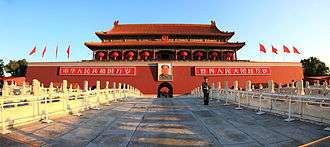2013 Tiananmen Square attack
| 2013 Tiananmen Square car attack | |
|---|---|
 The car crashed outside of the Gate of Heavenly Peace on Tiananmen Square | |
| Location | Beijing |
| Date | 28 October 2013 |
Attack type | Car attack (suspected suicide bombing)[1] |
| Deaths | 5 (including three attackers)[1] |
Non-fatal injuries | 38[1] |
| Perpetrators | East Turkestan Islamic Movement |
| Motive | Extremist Islamic beliefs |
On 28 October 2013, a car crashed in Tiananmen Square, Beijing, in what police described as a terrorist suicide attack.[2] Five people died in the incident; three inside the vehicle and two others nearby - one Filipino and the other a Chinese citizen from Guangdong province.[3][4] Police identified the driver as Usmen Hasan and the two passengers as his wife, Gulkiz Gini, and his mother, Kuwanhan Reyim.[3] Thirty-eight other people were injured.[3]
Chinese police described it as a "major incident"[2] and as the first terrorist attack in Beijing's recent history.[5] The East Turkestan Islamic Movement, or Turkistan Islamic Party, claimed responsibility and warned of future attacks.[6][7]
Incident
A 4x4 vehicle crashed into a crowd and burst into flames near the portrait of Mao Zedong at Tiananmen Square.[2] Three people inside the car were killed as well as two tourists in the square. Thirty-eight people were also injured in the incident.[2] Witnesses at the scene said that the car involved in the incident was beeping at pedestrians.
Investigation
Chinese police later issued a notice to Beijing hotels seeking information about two people from China's Xinjiang Uyghur Autonomous Region.[2] The notice described a vehicle and four Xinjiang number plates.[2] They also instructed hotels to be aware of "suspicious" guests.[8]
The police notice also requested hotels to report all guests who had registered since 1 October and the cars they had driven. The request was issued "In order to prevent the suspects and vehicles from committing more crimes".[9]
The suspects have names of Uyghurs, a Turkic Muslim minority group, and come from their native Xinjiang, a region in which there is ongoing conflict.[2] One suspect is from the town of Lukun in Shanshan County, the location of an incident in which 30 people died in an attack in June. Five suspects were taken into police custody and said they knew Hasan.[3] Three of the suspects, identified as Huseyin Guxur, Yusup Wherniyas and Yusup Ehmet, were convicted of masterminding the attack, and executed in August 2014.[10]
Top Chinese security official Meng Jianzhu said that the East Turkestan Islamic Movement (ETIM) was behind the attacks,[11] but Uighur exile groups and some Western observers disputed the claim.[12] On 24 November 2013, the Turkistan Islamic Party, which is believed to be the same as the ETIM, declared it was responsible for the attack.[6]
Reaction
A BBC camera crew was briefly detained by police after taking footage of the attack. Coverage in the Chinese state media has largely downplayed the incident with only brief reports.[13] Although details were given in English-language media, Chinese-language publications did not link the incident to Xinjiang.[8] Chinese internet users have also reposted and spread photographs of the incident.[9]
Six days after the attack, General Peng Yong, commander of the Xinjiang Military District, was removed from the Regional Party Standing Committee, the Communist Party governing body in Xinjiang, and replaced by Liu Lei, political commissar of the Xinjiang MD.[12]
The United States State Department spokesperson Jen Psaki said America supported China's investigation into the matter, but declined to call it a terrorist attack and reiterated American support for Uighur human rights.[11]
See also
References
- 1 2 3 Kang, Benjamin. "China suspects Tiananmen crash a suicide attack- sources". Reuters. Retrieved 30 October 2013.
- 1 2 3 4 5 6 7 "Tiananmen crash: China police 'seek Xinjiang suspects'". BBC News Online. 29 October 2013. Retrieved 29 October 2013.
- 1 2 3 4 "Chinese police say Tiananmen Square crash was 'premeditated, violent, terrorist attack". Washington Post. Associated Press. 30 October 2013. Retrieved 3 March 2014.
- ↑ Blau, R (27 June 2015). "Tongue Tied: Education in Xinjiang". The Economist. ISSN 0013-0613. Retrieved 2016-11-15.
- ↑ "China police call Tiananmen Gate suicide attack an act of terrorism, arrest 5 suspects". Washington Post. Associated Press. 31 October 2013. Retrieved 31 October 2013.
- 1 2 Islamist group claims responsibility for attack on China's Tiananmen Square.
- ↑ Turkestan Islamic Party Islamist group warns of more attacks such as Tiananmen
- 1 2 "China names Tiananmen Square car crash 'suspects'". Times of India. 29 October 2013. Retrieved 29 October 2013.
- 1 2 "Beijing Looks for Uighur Link After Tiananmen Fireball". TIME magazine. 29 October 2013. Retrieved 29 October 2013.
- ↑ "China executes eight, including Tiananmen attackers". BBC. 24 August 2014. Retrieved 29 August 2015.
- 1 2 Bodeen, Christopher (1 November 2013). "China: East Turkestan movement behind deadly crash". Bigstory.ap.org. Retrieved 5 November 2013.
- 1 2 Andrew Jacobs (3 November 2013). "China Strips Army Official of Position After Attack". The New York Times.
- ↑ "China police hunt Beijing explosion suspects". Al Jazeera. 29 October 2013. Retrieved 29 October 2013.